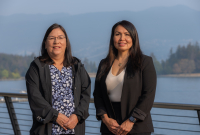Support strong Canadian climate journalism for 2025
Indigenous Peoples are now more likely to live in large urban centres than they were five years ago, according to the 2021 census from Statistics Canada.
The Indigenous population in urban centres with more than 100,000 people grew by 12.5 per cent since the last census in 2016. Percentage-wise, 44.3 per cent of the total Indigenous population now lives in large urban centres, up from 43.1 per cent in 2016.
The census used peoples’ usual place of residence for the statistics, rather than those temporarily living in urban centres to access medical care or other services.
The city with the greatest increase in Indigenous population was Edmonton, which saw an additional 11,400 people added to its population base, a 15 per cent increase. Next was Montreal at 11,265 (an increase of 32 per cent) and Winnipeg, which saw an increase of 8,750 Indigenous people to its population, up nine per cent from 2016. Toronto’s Indigenous population declined slightly.
About 421,000 First Nations peoples lived in large urban centres in 2021, accounting for 40 per cent of the total First Nations population. The number of those living in urban centres nearly doubled for non-status First Nations at 59 per cent compared to 33 per cent for status First Nations.
“The census highlights the booming Indigenous population in urban areas — a demographic Indigenous Services Canada must acknowledge and provide supports for,” Elmer St. Pierre, national chief of the Congress of Aboriginal Peoples, told Canada’s National Observer. “As our growth rate continues to outpace that of other Canadians, governments must address our pressing needs and tap into the growing potential our people offer.”
More than half of the Métis population lived in large urban centres (55 per cent), with Winnipeg home to the largest Métis population, followed by Edmonton, Calgary and Vancouver. Those four cities alone accounted for a quarter of the Métis population in Canada.
The urban Inuit population in 2021 amounted to 15 per cent of the total Inuit population, a 13 per cent increase since 2016. The largest Inuit population is in Ottawa-Gatineau, followed by Edmonton and Montréal.
But there still may be discrepancies in census reports when it comes to who is living in urban centres.
Joël Lamoureux, communications manager for Tungasuvvingat Inuit (an urban Inuit service provider based out of Ottawa and Toronto), estimates the Inuit population in Ottawa-Gatineau is likely more than double what the census numbers reflect — over 3,500.
The census takers are likely to miss people in insecure housing situations who might be couch-surfing with family and friends, Lamoureux said.
Fear and distrust of government can cause urban Inuit not to participate in surveys, he added.
The population growth seen by Tungasuvvingat Inuit, although not exact, can be seen in the necessary growth of their organization.
“The demand on our programs and services has been consistently increasing over the last several years, and certainly since the last census,” he says.
The demand for core services like housing and food security, in particular, has been increasing consistently in Ottawa.
For example, Rhonda Huneault told Canada’s National Observer that with the pandemic and inflation, lines at Tungasuvvingat Inuit’s food bank are growing longer.
Generally speaking, however, Tungasuvvingat Inuit is “encouraged” by the growth of the Inuit population, which is up 70,000 since the last census, he says.
All Indigenous Peoples who answered the census were self-identified.
Matteo Cimellaro / Local Journalism Initiative / Canada’s National Observer







Comments